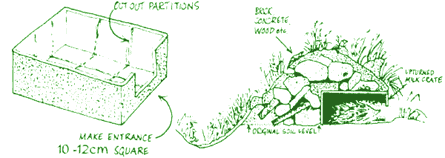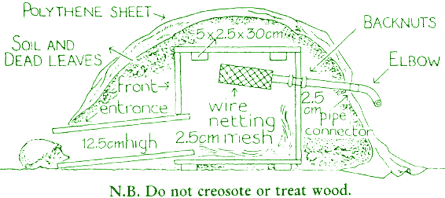



|
|
The following information was provided by the British Hedgehog Preservation Society (BHPS) and has been reproduced with their permission.
Efficient winter nests are essential if hedgehogs are to survive hibernation. Thus, in autumn, they begin to collect leaves (especially from deciduous trees), grass, straw, bracken, reeds etc. and use these materials for building their own nests under hedgerows, fallen logs or piles of brushwood. These 'hibernacula' prove to be surprisingly waterproof and good insulation against the cold.
Most gardens have a supply of the materials mentioned above and suitable sites for nests - under sheds, compost heaps, shrubs and piles of leaves or behind stacks of logs and under spare building materials. In these circumstances, if hedgehogs want to spend a winter here, they should be able to get on and build their own shelters. However, you may wish to provide your 'resident' hedgehog with (or encourage any in the vicinity to become 'resident' in your garden by the provision of) a more permanent structure, as described below.
In More Formal Gardens and in Other Enclosed Areas Where hedgehogs are being cared for (e.g. after an injury or when orphaned) they will probably need nests made for them. Hedgehog House - Mark 1 (Council Tax Band "A") This is a very simple affair and easy to make. Get a big, thick cardboard box and cut two side air vents about 15cm by 5cm and an entrance about 15cm in diameter. Put some shredded newspapers inside with clean, dry grass or straw on top and tuck the box near a hedge, if possible with the entrance facing South. The top of the box should then be covered with a small piece of plastic sheeting, for example, an 'opened up' old carrier bag. Twigs should then be put all round to make a dome and then covered with dry grass and leaves. Hedgehog House - Mark 2 (Council Tax Band "D") An upturned milkcrate, preferably plastic, buried into a mound will probably attract hedgehogs - a Hedgehog 'Prefab'! Cut out all the internal partitions of the crate with a coping saw or secateurs and make the entrance about 10-12cm square in one end of the crate, avoid leaving 'rough' edges. Set the crate into your rubbish mound and camouflage it well outside. Inside you can make it more inviting to hedgehogs by covering the floor with soil and leaves, or even torn up newspaper and a few small sticks.

Hedgehog House - Mark 3 (Council Tax Band "H") This is a design that the BHPS recommends and is a more permanent type of home. Any available timber can be used (old or new) but the better it is made, the longer it will last. Do not nail down the roof as you may need to clean the box in the future. The entrance tunnel could be constructed with old bricks placed on top of each other with a piece of slate with a brick atop for the roof. Make sure the entrance is kept clear and avoid the temptation to disturb the hedgehogs during hibernation.

The finished Home should be covered with plastic sheeting, soil and twigs placed on top and hay left outside which will be taken in and used for bedding by any prospective resident. Remember that hedgehogs have soft feet and so the floor of your Hedgehog House should have newspapers, sawdust or earth on it.
When you have made a Hedgehog House, place it in a quiet part of your garden, preferably against a bank, wall or fence and hope that you will have a visit from a friend seeking a home. Make sure the entrance to the house does not face North or North East, thus avoiding the cold winter winds. It may then become the winter home for some lucky hedgehog. If female, she may even have her young in it in the Spring. After winter use, it needs to be cleaned out and, to some extent, fumigated or washed out. To make sure there is nobody in residence, put a small amount of food into the entrance to see whether it disappears; if it doesn't, this is an indication that the hedgehog is no longer in residence and you can clean the house using Pyrethrum powder or one of the herbal dog dusting powders. On no account should the Hedgehog House be creosoted or "treated" as the fumes remain for a long time and can be very harmful. There are various "ready-made" Hedgehog Homes on the market, including the ones which can be obtained from the BHPS. |
|
 |
